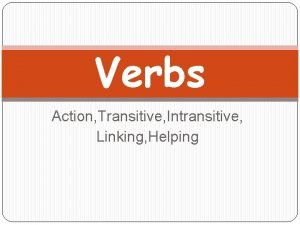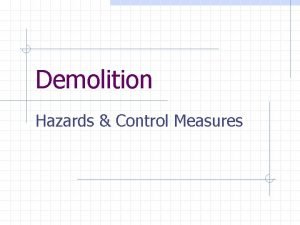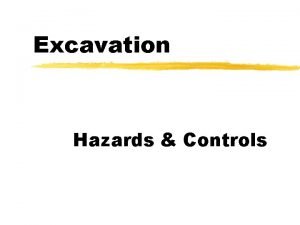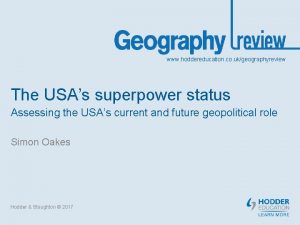www hoddereducation co ukgeographyreview Linking hazards and place














- Slides: 14

www. hoddereducation. co. uk/geographyreview Linking hazards and place An evaluation of hazard management models David Redfern Hodder & Stoughton © 2019

Introduction This presentation supports the following articles in GEOGRAPHY REVIEW Vol. 33, No. 1: ● Making connections: Hazard and place, pages 10– 12 ● NEA ideas: Hazard and place, page 41 Hodder & Stoughton © 2019

Hazard management models There are three main hazard management models: ● The hazard management cycle (HMC) ● The Park model ● The pressure and release (PAR) model Each of them make connections between a hazard and the place(s) affected by that hazard. Hodder & Stoughton © 2019

The value of modelling ● Models identify order, general trends and patterns. ● They allow deviations from the model in the real world to be highlighted. ● Models therefore make such deviations easier to explain. ● All of these models involve proactive stages of hazard management (mitigation and preparation) and reactive stages (response and recovery). ● They help shape our understanding of ‘resilience’: ‘The ability of a system, community or society exposed to hazards to resist, absorb, accommodate to and recover from the effects of a hazard in a timely and efficient manner, including through the preservation and restoration of its essential basic structures, systems and functions. ’ (UN) ● Inherently they are all optimistic – lessons can be learnt for the future management of such events.

The hazard management cycle (HMC) Hodder & Stoughton © 2019

The hazard management cycle (HMC) The HMC illustrates four stages in the management of hazards in seeking to reduce the scale of a disaster: preparedness, response, recovery, mitigation. Note the recovery (‘returning to normal’) stage depends on: ● the magnitude of the event ● the level of development of the area affected ● the level of governance of the area affected ● the external help available Hodder & Stoughton © 2019

The hazard management cycle (HMC): evaluation ● The HMC provides an easy to remember four–stage sequence. ● It is also centred around four ‘P’s: prediction, prevention, protection and preparedness. ● The model also features four ‘R’s: response, recovery, rehabilitation, reconstruction. ● The model is criticised for being too generic and unquantifiable. . . but is this a strength? ● Importantly, ‘place’ detail can be inserted into the model, rather than determining it. Hodder & Stoughton © 2019

The Park model Hodder & Stoughton © 2019

The Park model This model illustrates: ● how quality of life is impacted by a hazardous event ● how a range of management strategies can be used over time - from before the event to after the event ● the importance of the roles of emergency relief agencies and rehabilitation ● that different areas affected may have different response curves, depending on the level of preparedness and economic development of the place affected Hodder & Stoughton © 2019

The Park model: evaluation ● The model focuses on three ‘R’s: relief, rehabilitation and reconstruction. All of these help understanding of the ‘recovery’ phase after an event. ● It is criticised for not accounting for different levels of economic development, or including other issues (social, political, environmental) that may play a role. ● It is useful when comparing hazard events – they can have differing ‘curves’: – the steepness of the downward curve depends on the nature of the event – the depth of the downward curve reflects the scale of the event – the gradient of the upward curve depends on the level of development, and governance (provided both internally and externally) Hodder & Stoughton © 2019

The pressure and release (PAR) model Hodder & Stoughton © 2019

The pressure and release (PAR) model The PAR model shows that: ● The socioeconomic context of the place is important: the political systems (governance), income levels, economic strength, levels of education and training, rates of population change and levels of investment in a place all impact on its degree of vulnerability. ● The nature of the hazard is also key, whether a volcano, earthquake, storm or landslide. ● Both the context and the hazard put pressure on the place affected. ● The release of that pressure comes with a reduction in the vulnerability of the place affected, which in turn often depends on the quality of governance in the place. Hodder & Stoughton © 2019

The pressure and release (PAR) model: evaluation ● The PAR model shows how disasters occur when natural hazards affect vulnerable people. ● A disaster occurs when two forces (socioeconomic pressure and physical exposure) interact (or ‘collide’). ● The ‘root causes’ include all economic, demographic and political processes affecting the allocation and distribution of resources between different groups of people – which are a reflection of inequality in a population. ● The ‘dynamic pressures’ are the economic and political processes which produce unsafe conditions for the most vulnerable people ● ‘Unsafe conditions’ express such vulnerability, and include inadequacies in disasterpreparedness measures. Hodder & Stoughton © 2019

The importance of good governance All of the models show that effective governance has a significant impact on community resilience. Hodder & Stoughton © 2019
 Www hoddereducation com
Www hoddereducation com Example of positive feedback geography
Example of positive feedback geography Ansoff matrix dyson
Ansoff matrix dyson Www hoddereducation com
Www hoddereducation com Hodder definition
Hodder definition Dynamic picture
Dynamic picture Place place value and period
Place place value and period Disturbance that transfers energy
Disturbance that transfers energy A disturbance that transfers energy from place to place.
A disturbance that transfers energy from place to place. Transitive intransitive and linking verbs
Transitive intransitive and linking verbs Slip trip fall hazards
Slip trip fall hazards Demolition hazards and controls
Demolition hazards and controls Excavation hazards and controls
Excavation hazards and controls Workplace hazards and risks
Workplace hazards and risks Understanding hazards and risks
Understanding hazards and risks


























